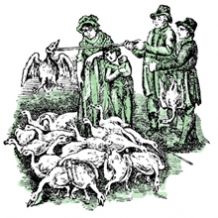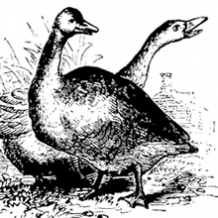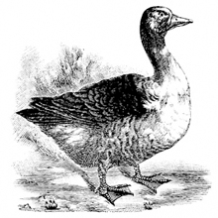History
History
Records of keeping geese for their ‘fat, grease and feathers’ date as far back as 2500BC when the ancient Egyptians began keeping the birds for food and deliberately fattening them, a practice which spread from Egypt to the Mediterranean.
The first written mention of Goose Husbandry was in 700BC. The Greek poet Homer spoke of geese in his epic The Odyssey, “A great eagle with curving beak flew down from the mountain and broke the necks of twenty geese I keep … With his words sweet sleep left me, and gazing round I saw the geese feeding on grain, by the trough in the yard, as ever."
However, it was not until the Roman period (about 625BC) that goose meat was mentioned as a distinct food and an efficient system was recorded for keeping geese. As well as keeping geese for their meat, fat and feathers, geese were also valued for their guarding duties, reportedly raising the alarm when Rome was attacked by the Gauls in 390BCE and thereby saving the city.
When the Roman Empire fell (around 476AD), geese became an integral part of the European peasant economy, touching the lives of the majority of men and women, who until the recent past, worked the land in family groups to secure their own survival. Geese, like pigs were an economical choice. They cost little to feed, gained weight quickly and produced excellent meat and plenty of spare fat.
Geese were clearly good for the economy, as shown in the establishment of Goose Fairs, which were held each September on St Matthew’s Day (the patron saint of bankers). Britain’s longest running fair is the Nottingham Goose Fair, which possibly started soon after the Charter of King Edward I was granted in the year 1284.
18th Century Britain saw geese being reared in large flocks (predominately in Norfolk, Suffolk and Lincolnshire) before being shod in tar and being marched to market. As well as providing meat, fat and feathers, the geese also satisfied the growing demand for ink quills.
One goose that was celebrated during this period was ‘Old Tom’ a gander which escaped execution at London’s Leadenhall Meat Market, even though 34,000 geese were reportedly slaughtered there in two days. ‘Old Tom’ became a great favourite at Leadenhall and lived out his days being fed by the local inns. When he died in 1835 at the age of 38, he was laid in state and buried in the marketplace.
Geese continued to be held in high esteem throughout the 19th Century. A perfect illustration is Grimm’s Fairy Tale, “Hans in Luck” which describes a young German boy who taking possession of a goose, says, “First there is the good roast meat, then the quantity of fat which will drip from it, and which will give me dripping for my bread for a quarter of a year.”
The 20th Century saw a new use for goose fat. During the 1930’s and 40’s goose fat was highly prized and saved for medicinal purposes. To remedy ‘colds on the chest’ goose fat was smeared onto brown paper and applied to the chest or back as a poultice. Sore throats could also be cured with a spoonful of ‘goose grease’.
Elizabeth David, who is considered responsible for bringing French food into the British home, was perhaps also responsible for saving goose fat from this medicinal fate. In an article in House & Garden (1958), she describes how to cook a Goose and writes, “The fat from the bird should be separated from the juices and poured off into a bowl, for it is very valuable for frying.”
In certain parts of France, goose fat still takes the place of butter or oil in cooking, particularly in the South Western regions of Aquitaine, Gascony and Périgord. Traditional dishes include pommes sarladaises (potatoes cooked in goose fat), Confit (from the french verb confir, which means to preserve), which is essentially goose cooked slowly and then cooled in its own fat and Cassoulet, a classic French bean stew which is flavoured with Confit.
In the UK, although vegetable and nut oils are still the preferred cooking medium, food-lovers are quickly discovering the culinary and nutritional benefits of cooking with goose fat. Goose Fat has been imported from France since the late eighties but reached greater heights in 2006, when celebrity chef Nigella Lawson championed it as ‘the essential Christmas cooking ingredient.” Goose Fat is now widely available from supermarkets, independents, delicatessens, farm shops and farmers markets nationwide.



